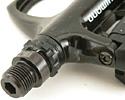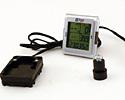Ritchey WCS Carbon 4-Axis stem - Best of both worlds
The WCS Carbon 4-Axis stem
from Ritchey
Photo ©: James Huang

|
The use of carbon fiber has brought about unprecedented weight
losses in just about every bicycle component it has touched… but
so far, with very few exceptions, handlebar stems aren't included
in that pile. High-end production aluminum stems regularly flirt
with the 100g mark, while full carbon ones often top that figure
by 100% (and no, we're not counting small volume offerings from
boutique builders). So are they sexy looking? Sure. Do they offer
the user more performance? Well, they're often more rigid, but if
you consider weight to be a large component of that performance
metric, then the answer is usually no.
Ritchey pledges to deliver the best of both materials with its
WCS Carbon 4-Axis stem, using what it says is a structural carbon
fiber skin fused over a forged 2014 aluminum 'skeleton' that combines
the best properties of each material (does that mean the stem is
just skin and bones?). According to Ritchey product development
manager Maris Adamovics, this 'Matrix carbonalloy' is "tougher
than carbon, and resists fatigue better than alloy."
Ritchey supplements the carbonalloy construction with a
similarly finished paired-four-bolt faceplate and its signature
bias-cut steerer clamp (both of which are claimed to reduce stress
on clamped parts), along with a full set of titanium hardware. At
the very least, the resultant 121g weight for our 110mm test sample
is impressive for any carbon stem, be it full carbon monocoque or
otherwise.
The faceplate uses four titanium
bolts
Photo ©: James Huang

|
All of this techno mumbo jumbo and marketing hype means nothing
if the product can't deliver on the bike, though. As compared to
a standard Ritchey WCS 4-Axis aluminum stem, the matrixalloy
version doesn't feel all that different on the road and is nearly
identical in weight. That's not necessarily a bad thing, though,
as the all-aluminum version is already surprisingly solid-feeling
given its feathery 118g weight. However, that similarity isn't necessarily
a good thing, either, as the WCS Carbon 4-Axis stem is twice as
expensive.
We can't confirm or deny Ritchey's fatigue improvement claims,
but to be fair, it's worth mentioning that components usually experience
the highest stresses on the surface and carbon fiber generally displays
better fatigue properties than aluminum, so things at least make
sense. Even if you go on the assumption that the fatigue improvement
is real, though, it's unlikely that the carbonalloy version
will last twice as long. The WCS Carbon 4-Axis stem is certainly
a nice piece of kit, but unless you have to have the carbon look,
we'd rather have two of the aluminum ones instead.
Weight: 121g (110mm extension)
Price: US$199.99
Pros: Carbon aesthetics but significantly lighter
than most full-carbon stems on market with a more elegant appearance,
carbon-friendly steerer and handlebar clamps, wide 90-130mm range
of extensions
Cons: Rather expensive, not enough of a performance
advantage over the standard aluminum version
Cyclingnews rating: 
More info: www.ritcheylogic.com
PhotographyFor a thumbnail gallery of these images, click here
Images by
James Huang/Cyclingnews.com

Shimano PD-R540 pedals - 'Lance Jr.'
Shimano's PD-R540 pedals
Photo ©: James Huang

|
At first glance, Shimano's PD-R540 pedal simply looks like a black
version of the pedal that Lance Armstrong made so famous (the one
he helped develop, that is, not the old Look-style ones he started
out on that Shimano was embarrassed to admit he used). To a large
extent, that assumption would be mostly true as the 105-level pedal
uses the same excellent SPD-SL retention system, easy-to-walk-in
cleats, and a nearly identical aluminum body (and no, it's not resin
like it says on Shimano's web site; we filed into ours to make sure).
To bring the price down to a more reasonable level, however, Shimano
equipped the PD-R540 with a cheaper bearing system that uses only
two sets per side (one roller bearing plus one adjustable angular
contact ball bearing) instead of Dura-Ace's three. The less expensive
chromoly axle and flat black finish bring the cost down to roughly
half of Shimano's top-end offering, and weight creeps up to 332g
per pair (without the 72g cleats).
In general, we'd be hard-pressed to tell any difference between
the PD-R540 and Lance's signature pedal while sitting in the saddle.
Entry and exit lose nothing in translation, and the bearing and
axle system, while technically inferior, offers up no noticeable
hint of its more humble roots. And what about the weight difference,
you ask? Weight weenies will undoubted pass on the PD-R540 for something
lighter (every little bit counts), but if you can honestly say that
you can feel fifty extra grams at the pedals while riding, we have
a job waiting for you.
One cost-cutting measure
is the axle and bearing system
Photo ©: James Huang

|
In fact, our only real gripe seems to lie in the black finish,
and we're not talking cosmetics here. The PD-R540 pedal offers the
same amount of float as Dura-Ace, but it just doesn't feel as smooth
or fluid as that black paint somehow adds appreciable friction to
what would otherwise be a superb system. Lubricating the front and
rear edges of the cleat helps quite a bit, though, but we've never
had to do that with its big brother.
All in all, though, the PD-R540 delivers outstanding value and
performance and would be an excellent choice for anyone looking
to save a little bit of coin.
Weight: 332g per pair (72g per pair for cleats and hardware)
Price: US$69.99
Pros: Superb SPD-SL performance, exceptional value, surefooted
cleats
Cons: Slightly stickier float as compared to upper-tier models
Cyclingnews rating: 
PhotographyFor a thumbnail gallery of these images, click here
Images by
James Huang/Cyclingnews.com

Korotek BionClino 401 computer - climber's delight
The BionClino 401 might just
be a climber's best friend
Photo ©: James Huang

|
These days it's become increasingly difficult for computers to
stand out from the crowd of competent 'me-too' models, but climbers
may take particular interest in the Korotek BionClino 401 which
might just provide exactly what they'd want to know when the road
points skyward.
The key to the BionClino 401 is an on-board accelerometer that
quickly detects changes in the angular position of the computer
head (from -30% to +30%), which is then combined with speed information
to yield instantaneous grade and rate of ascent. Unlike barometric
pressure- or GPS-based units that display averaged readings (which
can also drift with temperature), the BionClino's accelerometer
promises to react nearly immediately, meaning that now you can actually
tell exactly how steep it is in the apex of that switchback right
when your quads are screaming for mercy.
To sweeten the deal, the BionClino 401 also displays an estimated
power output during climbs. , However, this field is only calculated
and displayed at grades of 2% or more (where the majority of your
energy is spent on combating gravity) in order to retain some semblance
of accuracy. Sound too good to be true? Maybe. Did we mention yet
that the whole package only weighs 54g?
The BionClino 401 also calculates
power output
Photo ©: James Huang

|
It turns out that the gradient information is not only useful,
but quite amusing as well. While the BionClino 401 doesn't make
the climbs themselves any easier, it does offer a bit of entertainment
on the way up and maybe even some solace when particular pitches
proved steeper than originally thought. Interestingly, though, negative
slopes didn't display as readily as positive ones.
Power measurements proved to be astoundingly accurate on longer
sustained climbs (within a few percentage points of a PowerTap SL
2.4), but figures churned out during short power climbs are noticeably
a step behind and somewhat erratic. Unfortunately, this information
can't be downloaded later for review, but the information is still
useful nonetheless.
Otherwise, the BionClino 401 is a fairly pedestrian piece of hardware:
the display is fairly small and crowded, and the side-mounted buttons
are difficult to access while riding. However, we can't deny that
thing does work as advertised, and we'll admit that we're now a
bit spoiled on the additional capabilities. Still, though, the BionClino
is rather expensive; those living in mountainous regions can probably
figure out a way to justify your curiosity, but flatlanders have
better choices available to them.
Price: €109
Weight: 54g (including head, mount, and wheel magnet)
Pros: Instant display of grade and climbing rate, surprisingly
accurate power readout during ascents, easy installation and setup,
straightforward operation
Cons: High premium to pay for additional climbing-specific
features, otherwise rather mediocre
Cyclingnews rating: 
PhotographyFor a thumbnail gallery of these images, click here
Images by
James Huang/Cyclingnews.com
|








